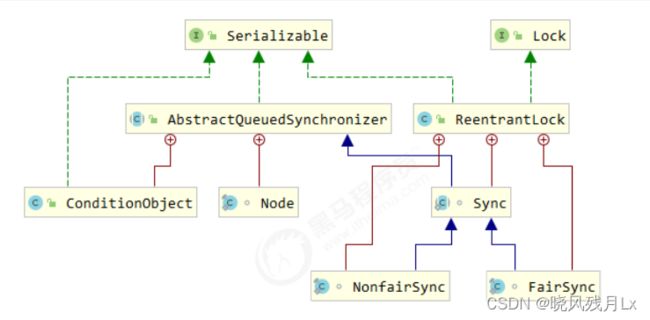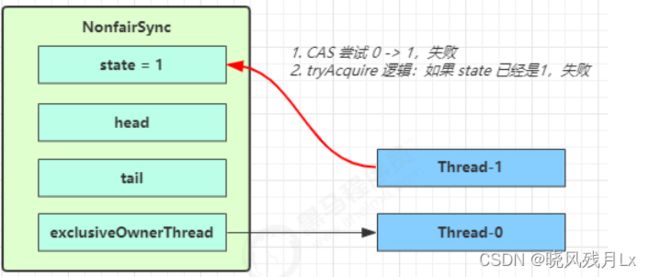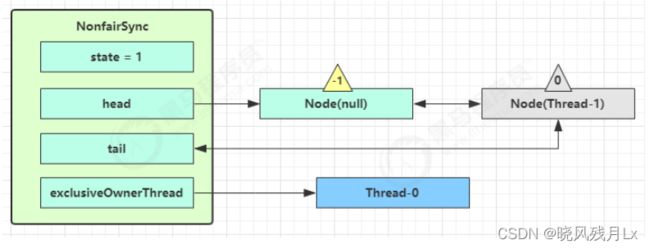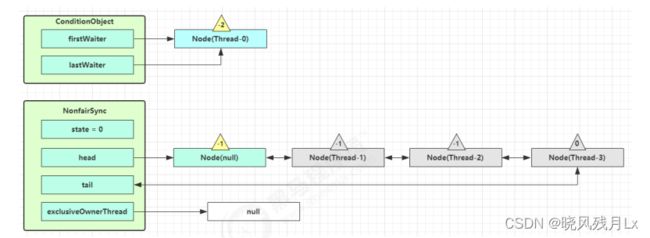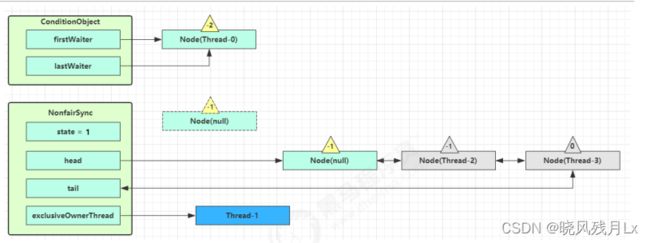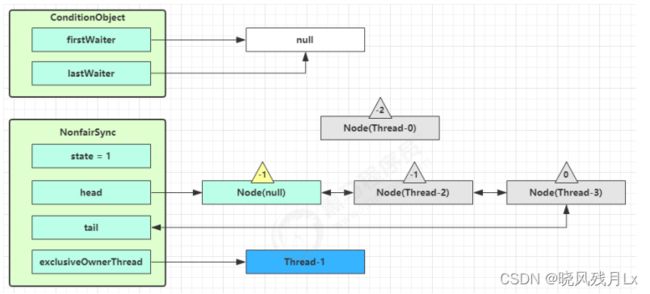JUC并发编程之ReentrantLock
1. 非公平锁实现原理
加锁解锁流程
构造器默认实现的是非公平锁
public ReentrantLock() {
sync = new NonfairSync();
}
NonfairSync 继承 Sync, Sync 继承 AbstractQueuedSynchronizer
没有竞争时
第一个竞争出现时
Thread-1 执行了
- CAS 尝试将state 由 0 改为 1,结果失败
- 进入 tryAcquire的逻辑,这时state已经是1,结果仍然失败
- 接下来进入 addWaiter 逻辑,构造Node队列
- 图中黄色三角形表示该 Node 的 waitStatus 状态,其中 0 为默认正常状态
- Node 的创建是懒惰的
- 其中第一个 Node 称为 Dummy(哑元)或者哨兵,用来占位,并不关联线程
当前线程进入 acquireQueued 逻辑
-
acquireQueued 会在一个死循环中不断尝试获取锁,失败后进入park阻塞
-
如果自己是紧邻着 head(排第二位),那么再次tryAcquire 尝试获取锁,当然这时state仍为 1,失败
-
进入 shouldParkAfterFailedAcquire 逻辑,将前驱 node, 即 head 的 waitStatus 改为 -1,这次返回false
-
shouldParkAfterFailedAcquire 执行完毕后回到 acquireQueued,再次 tryAcquire尝试获取锁,这时state 仍为1,失败
-
当再次进入 shouldParkAfterFailedAcquire 时,这时因为其前驱 node 的 WaitStatus 已经是 -1,这次返回的是 true
-
进入 parkAndCheckInterrupt,Thread-1 park(灰色)
再次有多个线程经历上述过程竞争失败,变成这个样子
Thread-0 释放锁,进入 tryRelease 流程,如果成功
- 设置 setExclusiveOwnerThread 为 null
- state = 0
当前队列不为 null,并且head的 waiteStatus = -1,进入 unparkSuccessor 逻辑
- 找到队列中离 head 最近的一个Node(没取消的),unpark 恢复其运行,即Thread-1
- 回到 Thread-1 的 acquireQueued 流程
如果加锁成功(没有竞争),会设置
- 设置 exclusiveOwnerThread 为 Thread-1,state = 1
- head 指向刚刚 Thread-1所在的Node,该Node 清空 Thread
- 原本的 head 因为从链表断开,而可被垃圾回收
如果这时候有其他线程来竞争(非公平锁)
如果又被 Thread-4 尝试加锁成功
- Thread-4 被设置为 exclusiveOwnerThread,state = 1
- Thread-1 再次进入 acquireQueued 流程,获取锁失败,重新进入 park 阻塞
加锁源码
// Sync 继承自 AQS
static final class NonfairSync extends Sync {
private static final long serialVersionUID = 7316153563782823691L;
/**
* Performs lock. Try immediate barge, backing up to normal
* acquire on failure.
*/
// 加锁实现
final void lock() {
// 首先用 cas 尝试(仅尝试一次)将 state 从 0 改为 1, 如果成功表示获得了独占锁
if (compareAndSetState(0, 1))
setExclusiveOwnerThread(Thread.currentThread());
else
// 如果尝试失败,进入 ㈠
acquire(1);
}
// tryAcquire
protected final boolean tryAcquire(int acquires) {
return nonfairTryAcquire(acquires);
}
}
// (一)从AQS继承过来的方法
public final void acquire(int arg) {
// tryAcquire
if (!tryAcquire(arg) &&
// 当 tryAcquire 返回 false时,调用 addWaiter (四),接着acquireQueued(五)
acquireQueued(addWaiter(Node.EXCLUSIVE), arg))
selfInterrupt();
}
// 从Sync 继承过来的方法
final boolean nonfairTryAcquire(int acquires) {
final Thread current = Thread.currentThread();
int c = getState();
// 如果没有获
if (c == 0) {
// 尝试用 cas 获得,这里体现了非公平性:不检查AQS队列
if (compareAndSetState(0, acquires)) {
setExclusiveOwnerThread(current);
return true;
}
}
// 如果已经获得了锁,线程还是当前线程,表示发生了锁重入
else if (current == getExclusiveOwnerThread()) {
// state++
int nextc = c + acquires;
if (nextc < 0) // overflow
throw new Error("Maximum lock count exceeded");
setState(nextc);
return true;
}
// 获取失败,回到调用处
return false;
}
// (四) AQS 继承过来的方法
private Node addWaiter(Node mode) {
// 将当前线程关联到一个Node 对象上,模式为独占模式
Node node = new Node(Thread.currentThread(), mode);
// 如果 tail 不等于 null, cas尝试将 Node 对象加入 AQS 队列尾部
Node pred = tail;
if (pred != null) {
node.prev = pred;
if (compareAndSetTail(pred, node)) {
// 双向链表
pred.next = node;
return node;
}
}
// 尝试将 Node 加入 AQS,进入(六)
enq(node);
return node;
}
// (六) AQS 继承过来的方法
private Node enq(final Node node) {
for (;;) {
Node t = tail;
if (t == null) {
// 还没有,设置head为哨兵节点(不对应线程,状态为0)
if (compareAndSetHead(new Node()))
tail = head;
} else {
// cas 尝试将 Node 对象加入 AQS 队列尾部
node.prev = t;
if (compareAndSetTail(t, node)) {
t.next = node;
return t;
}
}
}
}
// (五) AQS继承过来的方法
final boolean acquireQueued(final Node node, int arg) {
boolean failed = true;
try {
boolean interrupted = false;
for (;;) {
final Node p = node.predecessor();
// 上一个节点是 head, 表示轮到自己了(当前线程对应的node),尝试获取
if (p == head && tryAcquire(arg)) {
// 获取成功,设置自己(当前线程对应的 node) 为head
setHead(node);
// 上一个节点 help gc
p.next = null;
failed = false;
// 返回中断标记 false
return interrupted;
}
if (
// 判断是否应当park,进入(七)
shouldParkAfterFailedAcquire(p, node) &&
// park等待,此时 Node 的状态被置为 Node.SIGNAL SIGNAL = -1(八)
parkAndCheckInterrupt())
interrupted = true;
}
} finally {
if (failed)
cancelAcquire(node);
}
}
// (七) AQS继承过来的方法
private static boolean shouldParkAfterFailedAcquire(Node pred, Node node) {
// 获取上一个节点的状态(上面图中黄色三角形的值)
int ws = pred.waitStatus;
if (ws == Node.SIGNAL)
// 如果上一个节点都在阻塞,那么自己也阻塞
return true;
// > 0 表示取消状态
if (ws > 0) {
// 上一个节点取消,那么重构删除前面所有取消的节点,返回到外层循环重试
do {
node.prev = pred = pred.prev;
} while (pred.waitStatus > 0);
pred.next = node;
} else {
// 这次还没有阻塞
// 但下次如果重试不成功,则需要阻塞,这时需要设置上一个节点状态为 Node。SIGNAL
compareAndSetWaitStatus(pred, ws, Node.SIGNAL);
}
return false;
}
// (八)阻塞当前线程
private final boolean parkAndCheckInterrupt() {
LockSupport.park(this);
return Thread.interrupted();
}
- 是否需要 unpark 是由当前节点的前驱节点的 waitStatus == Node.SIGNAL 来决定,而不是本节点的 waitStatus 决定
解锁源码
// 解锁实现
public void unlock() {
sync.release(1);
}
// AQS 继承过来的方法
public final boolean release(int arg) {
// 尝试释放锁,进入(一)
if (tryRelease(arg)) {
// 队列头结点 unpark
Node h = head;
if (
// 队列不为 null
h != null &&
// waitStatus == Node.SIGNAL 才需要 unpark
h.waitStatus != 0
)
// unpark AQS中等待的线程 进入 (二)
unparkSuccessor(h);
return true;
}
return false;
}
// (一)Sync 继承过来的方法
protected final boolean tryRelease(int releases) {
// state --
int c = getState() - releases;
if (Thread.currentThread() != getExclusiveOwnerThread())
throw new IllegalMonitorStateException();
boolean free = false;
// 支持锁重入,只有 state 减为0,才释放成功
if (c == 0) {
free = true;
setExclusiveOwnerThread(null);
}
setState(c);
return free;
}
// (二) AQS继承过来的方法
private void unparkSuccessor(Node node) {
// 如果状态为 Node.SIGNAL 尝试重置状态为 0
// 不成功也可以
int ws = node.waitStatus;
if (ws < 0)
compareAndSetWaitStatus(node, ws, 0);
// 找到需要 unpark 的节点,但本节点从 AQS 队列中脱离,是由唤醒节点完成的
Node s = node.next;
// 不考虑已取消的节点,从 AQS 队列从后至前找到队列最前面需要 unpark 的节点
if (s == null || s.waitStatus > 0) {
s = null;
for (Node t = tail; t != null && t != node; t = t.prev)
if (t.waitStatus <= 0)
s = t;
}
if (s != null)
LockSupport.unpark(s.thread);
}
2. 可重入原理
protected final boolean tryRelease(int releases) {
// state --
int c = getState() - releases;
if (Thread.currentThread() != getExclusiveOwnerThread())
throw new IllegalMonitorStateException();
boolean free = false;
// 支持锁重入,只有state减为0的时候才会释放成功
if (c == 0) {
free = true;
setExclusiveOwnerThread(null);
}
setState(c);
return free;
}
final boolean nonfairTryAcquire(int acquires) {
final Thread current = Thread.currentThread();
int c = getState();
if (c == 0) {
if (compareAndSetState(0, acquires)) {
setExclusiveOwnerThread(current);
return true;
}
}
// 支持锁重入,当 state不为0,即已经获得了锁,线程还是当前线程,表示发生了锁重入
else if (current == getExclusiveOwnerThread()) {
int nextc = c + acquires;
if (nextc < 0) // overflow
throw new Error("Maximum lock count exceeded");
setState(nextc);
return true;
}
return false;
}
3. 可打断原理
不可打断模式
在此模式下,即使它被打断,仍会驻留在AQS队列中,一直等到获得锁后方能得知自己被打断了
private final boolean parkAndCheckInterrupt() {
// 如果打断标记已经是true,则park会失效
LockSupport.park(this);
// interrupted 会清除打断标记
return Thread.interrupted();
}
final boolean acquireQueued(final Node node, int arg) {
boolean failed = true;
try {
boolean interrupted = false;
for (;;) {
final Node p = node.predecessor();
if (p == head && tryAcquire(arg)) {
setHead(node);
p.next = null; // help GC
failed = false;
// 获得锁后,才能返回打断状态
return interrupted;
}
if (shouldParkAfterFailedAcquire(p, node) &&
parkAndCheckInterrupt())
// 如果是因为 interrupt 被唤醒, 返回打断状态为 true
interrupted = true;
}
} finally {
if (failed)
cancelAcquire(node);
}
}
public final void acquire(int arg) {
if (!tryAcquire(arg) &&
acquireQueued(addWaiter(Node.EXCLUSIVE), arg))
// 如果打断状态为 true
selfInterrupt();
}
static void selfInterrupt() {
// 重新产生一次中断
Thread.currentThread().interrupt();
}
可打断模式
public final void acquireInterruptibly(int arg)
throws InterruptedException {
if (Thread.interrupted())
throw new InterruptedException();
// 如果没有获得锁,进入(一)
if (!tryAcquire(arg))
doAcquireInterruptibly(arg);
}
// (一)可打断的获取锁流程
private void doAcquireInterruptibly(int arg)
throws InterruptedException {
final Node node = addWaiter(Node.EXCLUSIVE);
boolean failed = true;
try {
for (;;) {
final Node p = node.predecessor();
if (p == head && tryAcquire(arg)) {
setHead(node);
p.next = null; // help GC
failed = false;
return;
}
if (shouldParkAfterFailedAcquire(p, node) &&
parkAndCheckInterrupt())
// 在 park 过程中如果被 interrupt 会进入此
// 这时候抛出异常,而不会在进入 for(;;;)
throw new InterruptedException();
}
} finally {
if (failed)
cancelAcquire(node);
}
}
4. 公平锁实现原理
static final class FairSync extends Sync {
private static final long serialVersionUID = -3000897897090466540L;
final void lock() {
//(一)
acquire(1);
}
// (二) 与非公平锁的区别就在tryAcquire 方法实现的不同
protected final boolean tryAcquire (int acquires) {
final Thread current = Thread.currentThread();
int c = getState();
if (c == 0) {
if (
// (三)先检查AQS队列中是否有前驱节点,没有才会去竞争
!hasQueuedPredecessors() &&
compareAndSetState(0, acquires)) {
setExclusiveOwnerThread(current);
return true;
}
}
else if (current == getExclusiveOwnerThread()) {
int nextc = c + acquires;
if (nextc < 0)
throw new Error("Maximum lock count exceeded");
setState(nextc);
return true;
}
return false;
}
}
// (一)从AQS 继承的
public final void acquire(int arg) {
if (
// (二)
!tryAcquire(arg) &&
acquireQueued(addWaiter(Node.EXCLUSIVE), arg))
{
selfInterrupt();
}
}
// (三)
public final boolean hasQueuedPredecessors() {
Node t = tail;
Node h = head;
Node s;
// h != t 时 表示队列中有 Node
return h != t &&
// (s = h.next) == null 表示队列中还有没有别的线程
// s.thread != Thread.currentThread() 队列中还有别的线程但不是此线程
((s = h.next) == null || s.thread != Thread.currentThread());
}
5. 条件变量实现原理
每个条件变量其实对应一个等待队列,其实现类是 ConditionObject
await 流程
开始 Thread - 0 持有锁,调用 await,进入ConditionObject 的 addConditionWaiter 流程
创建新的 Node状态为 -2 (Node.CONDITION),关联 Thread-0,加入等待队列尾部
接下来进入 AQS 的 fullyRelease 流程, 释放同步器上的锁
unpark AQS队列中的下一个节点, 竞争锁,假设没有其他竞争线程,那么Thread-1 竞争成功
park 阻塞 Thread-0
signal 流程
假设 Thread-1 要来唤醒 Thread-0
进入 ConditionObject 的 doSignal 流程,取得等待队列中第一个 Node,即 Thread-0所在 Node
执行 transferForSignal 流程,将该 Node 加入 AQS 队列尾部,将 Thread-0 的 waitStatus 改为 0, Thread-3 的waitStatus 改为 -1
Thread-1释放锁,进入 unlock 流程
源码
public class ConditionObject implements Condition, java.io.Serializable {
private static final long serialVersionUID = 1173984872572414699L;
// 第一个等待节点
private transient Node firstWaiter;
// 最后一个等待节点
private transient Node lastWaiter;
public ConditionObject() { }
// (一) 添加一个 Node 至等待队列
private Node addConditionWaiter() {
Node t = lastWaiter;
// 所有已取消的 Node 从队列链表删除
if (t != null && t.waitStatus != Node.CONDITION) {
unlinkCancelledWaiters();
t = lastWaiter;
}
// 创建一个关联当前线程新的Node,添加至队列尾部
Node node = new Node(Thread.currentThread(), Node.CONDITION);
if (t == null)
firstWaiter = node;
else
t.nextWaiter = node;
lastWaiter = node;
return node;
}
//(二)删除已取消的Node
private void unlinkCancelledWaiters() {
Node t = firstWaiter;
Node trail = null;
while (t != null) {
Node next = t.nextWaiter;
if (t.waitStatus != Node.CONDITION) {
t.nextWaiter = null;
if (trail == null)
firstWaiter = next;
else
trail.nextWaiter = next;
if (next == null)
lastWaiter = trail;
}
else
trail = t;
t = next;
}
}
// 唤醒 - 将没取消的第一个节点转移至 AQS 队列
private void doSignal(Node first) {
do {
// 已经是尾节点
if ( (firstWaiter = first.nextWaiter) == null)
lastWaiter = null;
first.nextWaiter = null;
} while (
// 将等待队列中的 Node 转移至 AQS 队列,不成功且还有节点则继续循环(三)
!transferForSignal(first) &&
(first = firstWaiter) != null);
}
// (三) 外部方法,方便阅读,放在这
// 如果节点状态是取消, 返回 false 表示转移失败, 否则转移成功
final boolean transferForSignal(Node node) {
// 如果状态已经不是 Node.CONDITION,说明被取消了
if (!compareAndSetWaitStatus(node, Node.CONDITION, 0))
return false;
// 加入 AQS 队列尾部
Node p = enq(node);
int ws = p.waitStatus;
if (
// 上一个节点被取消
ws > 0 ||
// 上一个节点不能设置状态为 Node.SIGNAL
!compareAndSetWaitStatus(p, ws, Node.SIGNAL)
){
// unpark 取消阻塞,让线程重新同步状态
LockSupport.unpark(node.thread);
}
return true;
}
// 全部唤醒 - 等待队列的所有节点转移至 AQS 队列
private void doSignalAll(Node first) {
lastWaiter = firstWaiter = null;
do {
Node next = first.nextWaiter;
first.nextWaiter = null;
transferForSignal(first);
first = next;
} while (first != null);
}
// 唤醒 - 必须持有锁才能唤醒, 因此 doSignal 内无需考虑加锁
public final void signal() {
if (!isHeldExclusively())
throw new IllegalMonitorStateException();
Node first = firstWaiter;
if (first != null)
doSignal(first);
}
// 全部唤醒- 必须持有锁才能唤醒, 因此 doSignalAll内无需考虑锁
public final void signalAll() {
if (!isHeldExclusively())
throw new IllegalMonitorStateException();
Node first = firstWaiter;
if (first != null)
doSignalAll(first);
}
// 不可打断等待 - 直到被唤醒
public final void awaitUninterruptibly() {
// 添加一个 Node 至等待队列 (一)
Node node = addConditionWaiter();
// 释放节点所持有的锁 (四)
int savedState = fullyRelease(node);
boolean interrupted = false;
// 如果该节点还没有转移至 AQS 队列,阻塞
while (!isOnSyncQueue(node)) {
// park 阻塞
LockSupport.park(this);
// 如果被打断,仅设置打断状态
if (Thread.interrupted())
interrupted = true;
}
// 唤醒后,尝试竞争锁,如果失败进入 AQS 队列
if (acquireQueued(node, savedState) || interrupted)
selfInterrupt();
}
//(四)因为某线程可能重入,需要将 state 全部释放
final int fullyRelease(Node node) {
boolean failed = true;
try {
int savedState = getState();
if (release(savedState)) {
failed = false;
return savedState;
} else {
throw new IllegalMonitorStateException();
}
} finally {
if (failed)
node.waitStatus = Node.CANCELLED;
}
}
// 打断模式 - 在退出等待时重新设置打断状态
private static final int REINTERRUPT = 1;
// 打断模式 - 在退出等待时抛出异常
private static final int THROW_IE = -1;
// 判断打断模式
private int checkInterruptWhileWaiting(Node node) {
return Thread.interrupted() ?
(transferAfterCancelledWait(node) ? THROW_IE : REINTERRUPT) :
0;
}
// (五) 应用打断模式
private void reportInterruptAfterWait(int interruptMode)
throws InterruptedException {
if (interruptMode == THROW_IE)
throw new InterruptedException();
else if (interruptMode == REINTERRUPT)
selfInterrupt();
}
// 等待 - 直到被唤醒或打断
public final void await() throws InterruptedException {
if (Thread.interrupted())
throw new InterruptedException();
// 添加一个 Node 至等待队列, 见 ㈠
Node node = addConditionWaiter();
// 释放节点持有的锁
int savedState = fullyRelease(node);
int interruptMode = 0;
// 如果该节点还没有转移至 AQS 队列, 阻塞
while (!isOnSyncQueue(node)) {
// 阻塞
LockSupport.park(this);
// 如果被打断,推出等待队列
if ((interruptMode = checkInterruptWhileWaiting(node)) != 0)
break;
}
// 退出等待队列,还需要获得 AQS 队列的锁
if (acquireQueued(node, savedState) && interruptMode != THROW_IE)
interruptMode = REINTERRUPT;
// 所有已取消的 Node 从队列链表删除 (二)
if (node.nextWaiter != null) // clean up if cancelled
unlinkCancelledWaiters();
// 应用打断模式 (五)
if (interruptMode != 0)
reportInterruptAfterWait(interruptMode);
}
// 等待 - 直到被唤醒或打断或超时
public final long awaitNanos(long nanosTimeout)
throws InterruptedException {
if (Thread.interrupted())
throw new InterruptedException();
// 添加一个 Node 至等待队列, 见 ㈠
Node node = addConditionWaiter();
// 释放节点持有的锁 (四)
int savedState = fullyRelease(node);
// 获得最后期限
final long deadline = System.nanoTime() + nanosTimeout;
int interruptMode = 0;
// 如果该节点还没有转移至 AQS
while (!isOnSyncQueue(node)) {
// 已超时,推出等待队列
if (nanosTimeout <= 0L) {
transferAfterCancelledWait(node);
break;
}
// park 阻塞一定时间, spinForTimeoutThreshold 为 1000 ns
if (nanosTimeout >= spinForTimeoutThreshold)
LockSupport.parkNanos(this, nanosTimeout);
// 如果被打断, 退出等待队列
if ((interruptMode = checkInterruptWhileWaiting(node)) != 0)
break;
nanosTimeout = deadline - System.nanoTime();
}
// 退出等待队列后, 还需要获得 AQS 队列的锁
if (acquireQueued(node, savedState) && interruptMode != THROW_IE)
interruptMode = REINTERRUPT;
// 所有已取消的 Node 从队列链表删除, 见(二)
if (node.nextWaiter != null)
unlinkCancelledWaiters();
// 应用打断模式, 见 (五)
if (interruptMode != 0)
reportInterruptAfterWait(interruptMode);
return deadline - System.nanoTime();
}
// 等待 - 直到被唤醒或打断或超时, 逻辑类似于 awaitNanos
public final boolean awaitUntil(Date deadline)
throws InterruptedException {
}
// 等待 - 直到被唤醒或打断或超时, 逻辑类似于 awaitNanos
public final boolean await(long time, TimeUnit unit)
throws InterruptedException {
}
// 略
}
